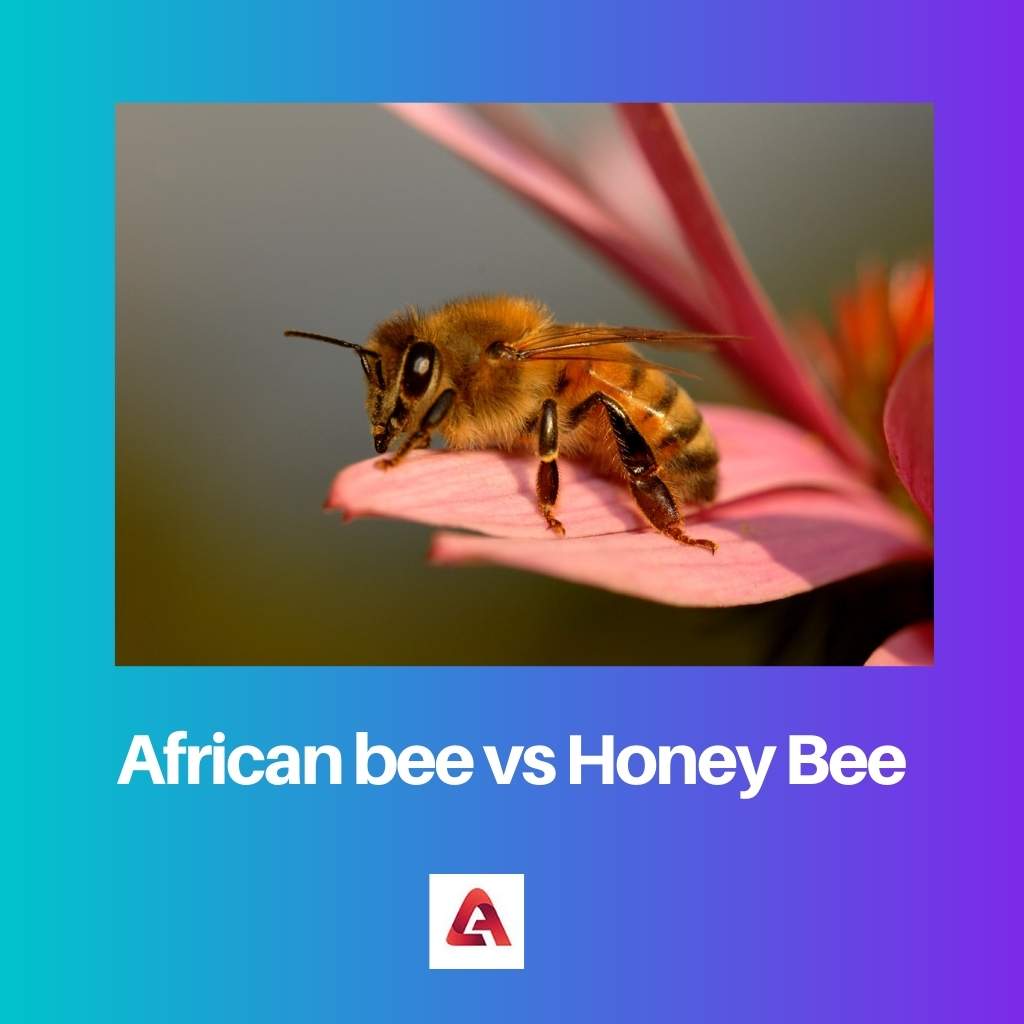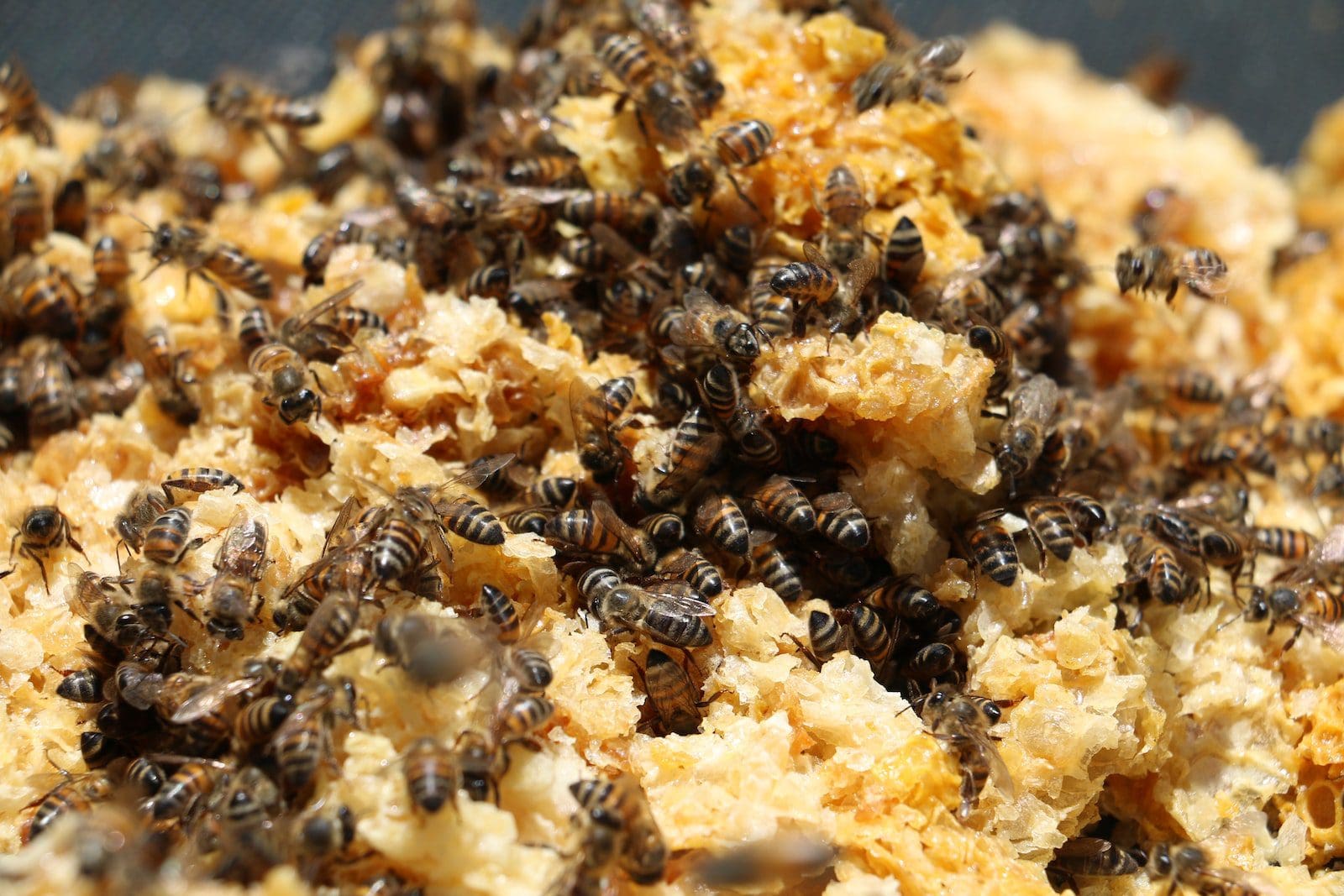Bees are pests with wings that are related to flies and ants. They are recognized for their fertilization. In the circumstance of the greatest recognized bee species, honey production.
Honey Bees are now considered a clade known as Anthophila. Bees are a monocot heritage with the Apoidea family.
Key Takeaways
- African bees are more aggressive and defensive, making them less suitable for beekeeping and honey production.
- Honey bees are more docile and easier to manage, making them the preferred species for honey production and pollination.
- African bees produce smaller amounts of honey and tend to swarm more than honey bees.
African bee vs Honey Bee
African bees are smaller and more aggressive bees, with a tendency to swarm and attack in large numbers in response to perceived threats. Honey bees are larger and less aggressive than African bees, with a tendency to produce honey and pollinate crops. They are domesticated for their honey.

African Honey Bees pose a threat because they attack home invaders in far larger figures than Honey Bees. They have slaughtered more than 1,000 people from their onset in Brazil, with toughies receiving 10 times the total of stings as the honey bee.
The African bee generates so much less honey than the honey bee. The only arthropod that generates sustenance for humans is the honey bee.
A honey bee can fly up to six miles and at speeds of up to 15 miles per hour; therefore, to create one pound of syrup, it would have to go 90,000 miles — three times around the world.
Comparison Table
| Parameters of Comparison | African Bee | Honey Bee |
|---|---|---|
| Sting | Almost all bees sting. | All do not bees sting. |
| Food | Pollen and nectar are their main sources of nutrition. | Honey is the winter food of bees. |
| Pollination | Even if a region has been overrun by African bees, crop pollination can continue. | Bees pollinate one out of every three mouthfuls humans consume. |
| Colony | The bees don’t stay in one place for long. | A honeybee colony is similar to a tree. |
| Honey production | Produces less honey. | Produce more honey. |
What is African Bee?
The Single bite from any African bee is not toxic as compared to a sting from any honey bee, though East African honey bees react more rapidly when troubled than honey bees. They will also continue pursuing an intruder further away from the hive.
Even though folks have died, this is a straight consequence of 100 to 300 African bee stings; the ordinarily fatal dosage for any human being is 500 to 1000 African bee stings.
Concerning the economic manufacture of honey, the African bee produces very much less honey as compared to the honey bee, while also generating more swarms and absconding.
Nearly all African bees sting. All African bees consider Pollen and nectar as their main sources of nutrition. Even if a region has been overrun by African bees, crop pollination can continue. The African bees don’t stay in one place for long.
As a result, African honey bees are not as much wanted as honey bees without the tendency of African military apiculturists to choose between the two because the African honey bees tend to attack and take over the Honey bee’s nest.
The African honey bee is similar to the honey bee in appearance. Pollen and nectar are the main sources of nutrition for any African bee.

What is Honey Bee?
Honey bees have originated in Asia’s southeast and southern parts. All existing classes, excluding Apis mellifera, are innate to that area. Alive senates of the earliest enthusiastically different ancestries have their origins there.
Close families of current honey bees, including stingless bees and bumblebees, are social to some amount. Communal behaviour seems to be a plesiomorphic representation that leads to the genus’s origin.
The more primitive Apis species have exposed combs, and the more recently developed Apis species have many combs and nest in pores, which has significantly assisted their husbandry.
Whenever the temperature goes down below 10 °C or 50 °F, honey bees stop flying and congregate in the centre of the beehive and try to create something called a “winter cluster.”
Workers group everywhere around the queen African bee, which is present in the centre. They all try to retain the core temperature between 27 °C or 81 °F at the beginning of the winter season and 34 °C or 93 °F after the queen African bee resumes laying eggs.
The outer edges of the bunch remain around 8–9 °C (46–48 °F). The cluster becomes more compact as the temperature drops outside. During the winter, they produce heat by using honey that has been preserved.

Main Differences Between African Bee and Honey Bee
- African bees sting. But not every honey bee stings.
- African bees feed on pollen and nectar, whereas honey bees feed on honey as winter food.
- Crop pollination can continue even if an area has been completely colonized by African bees. Whereas One out of every three mouthfuls we eat is pollinated by honey bees.
- African bees keep on changing their residence colonized, but honey bees colonies for, say, on trees.
- African bees produce less honey as compared to honey bees.
- African bees don’t stay in one place for long. Whereas A honeybee colony is similar to a tree.

- https://link.springer.com/article/10.1007/s12041-019-1145-7
- https://www.tandfonline.com/doi/abs/10.3896/IBRA.1.53.1.03

The article provides an excellent analysis and comparison between African bees and Honey Bees, very informative.
The article seems to be biased and leans towards favoring Honey Bees over African bees. More unbiased information is required in order to value each species.
This article is quite insightful. It provides a comprehensive comparison between African bees and Honey Bees.
The content is rich in the information provided. A good source for a comprehensive understanding of African bees and Honey Bees.
I couldn’t agree more! The article is quite informative.
Absolutely! This article offers a wealth of information about the genetics, behavior, and characteristics of African bees and Honey Bees.
The article provides a detailed comparison between African bees and Honey Bees, but the negative aspects could be highlighted further.
I disagree, the negative aspects were thoroughly explained. This is a great source of information!
A very interesting and comprehensive article about the comparison between African bees and Honey Bees. Good source references.
While the article provides valuable information, it could include a more detailed discussion about the economic impact of African bees and Honey Bees on different regions.
This is an exceptional article with great insights on the characteristics and traits of African bees and Honey Bees.